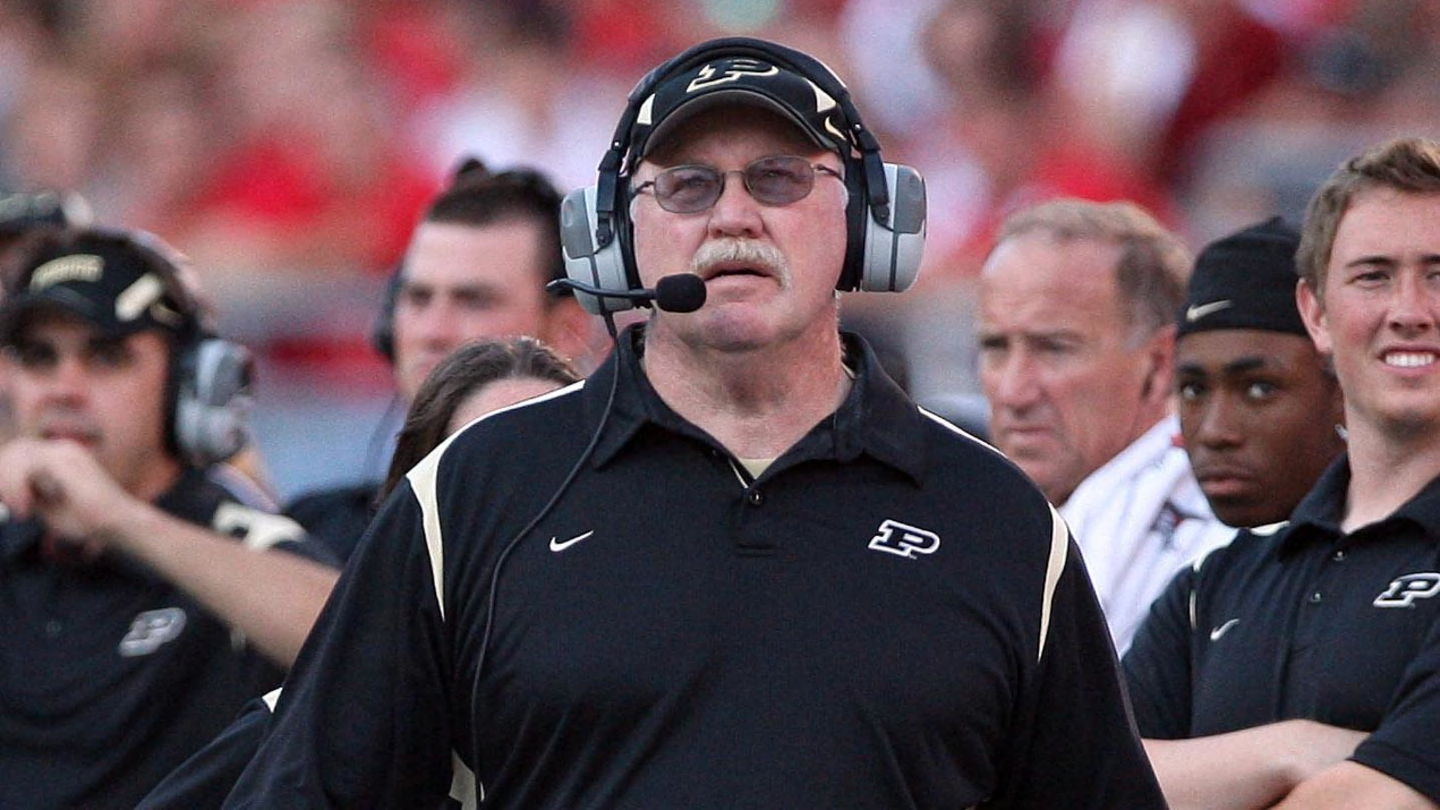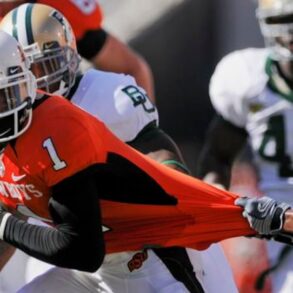
When the National Football Foundation (NFF) announced it was altering its criteria for enshrinement into the College Football Hall of Fame by lowering the minimum winning percentage, I immediately opened the calculator app on my phone. I typed in Joe Tiller’s numbers: 126 victories out of 219 games coached. Would it be high enough to earn a spot on the ballot finally?
Unfortunately, it’s not.
Last week, the NFF announced that it would lower its minimum winning percentage from .600 to .595 for consideration for the College Football Hall of Fame. Although the press release didn’t specifically address it, the belief is that the requirement was lowered so that the late college football coach Mike Leach could earn a spot in Atlanta. The former Texas Tech, Washington State, and Mississippi State coach had a .596 winning percentage in 21 seasons.
For those curious, Tiller’s final winning percentage after 18 seasons—six at Wyoming and 12 at Purdue—was .575. As of right now, Purdue’s all-time winningest football coach remains ineligible for the College Football Hall of Fame.
Nobody from the NFF asked for my opinion on the matter, but if they did, I’d give them my true thoughts. I’d ask them to ditch the winning percentage requirement and create a path for Tiller to receive enshrinement.
Tiller’s impact on the Big Ten and college football as a whole far outweighs his win percentage as a head coach, especially when we’re talking about a mere two percentage points. Not only did he have tremendous success at Purdue, but he was also an offensive genius who changed the way the game was played.
Before I begin talking about the overall impact Tiller had on college football, let’s start with his accomplishments at Purdue. That alone should be enough for Hall of Fame consideration.
After a six-year run at Wyoming and a 10-2 season in 1996, Tiller was hired to be the next coach at Purdue. He inherited one of the Big Ten’s worst programs, struggling with any relevance for nearly two decades.
When Tiller arrived in 1997, he took over a program that had gone 12 years without a bowl appearance and hadn’t won a conference championship in 30 seasons. He turned Purdue into a winner instantly, posting a 9-3 record in his first season, which included a win over Oklahoma State in the Alamo Bowl.
That season kickstarted Purdue’s run of eight bowl games in eight seasons. In the 16 years before Tiller’s arrival, the Boilermakers made just one postseason appearance, the 1984 Peach Bowl.
It took just four seasons for Tiller to lead Purdue back to the top of the Big Ten, winning a league title in 2000, thanks to the play of Heisman finalist quarterback Drew Brees. For the first time since 1967, the Boilers earned a trip to the Rose Bowl.
Across Tiller’s 12 seasons at Purdue, he posted an 87-62 record, including a 53-43 mark in Big Ten play. The Boilermakers endured just two losing seasons under Tiller, finishing 5-6 in 2005 and 4-8 in 2008. He remains Purdue’s all-time winningest football coach.
Tiller’s success in West Lafayette earned him a spot in two Hall of Fames: the Indiana Football Hall of Fame (2012) and the Purdue Athletics Hall of Fame (2013). Yet that arbitrary winning percentage has kept his name out of Atlanta for more than a decade.
When you flip on the television on Saturday afternoons in the fall, you’ll see Tiller’s fingerprints all over the game. His offensive ingenuity and outside-the-box thinking transformed the way college football was played, especially in the Big Ten.
This isn’t just some writer making it up as he goes, either. Some of Tiller’s former peers were quick to point out his influence on the game.
“He changed the Big Ten,” former Ohio State coach Urban Meyer said in 2017 in a video following Tiller’s passing. “He changed college football in a lot of ways with his approach to football.”
“‘Basketball on Grass,’ it really changed the way the Big Ten operated, as far as how you had to defend and the things he did initially there with Drew (Brees),” ex-Northwestern coach Pat Fitzgerald said.
That “basketball on grass” style brought new energy and excitement to Purdue football, something that hadn’t existed for years. It also stymied defensive coordinators across the conference.
Think about this: Three of the Big Ten’s top four receivers went to Purdue and played for Tiller. John Standeford is still the league’s all-time leading receiver, totaling 3,618 yards from 2000-03. Dorien Bryant ranks second with 3,548 yards (2005-08), and Taylor Stubblefield sits in fourth with 3,433 yards (2001-04).
Purdue also has six quarterbacks who are among the top-20 all-time passers in Big Ten history. Three of them — Curtis Painter (2005-08), Drew Brees (1997-2000), and Kyle Orton (2001-04) — played for Tiller.
Before Tiller arrived in West Lafayette, the Big Ten was a traditional “three yards and a cloud of dust” conference. He revolutionized the way the game was played offensively. Shouldn’t that be worth a few percentage points in the win column to the Hall of Fame?
I understand why there’s a minimum winning percentage for coaches to be considered for the College Football Hall of Fame induction. When it comes to enshrinement, there should be some standard of excellence.
Winning percentage isn’t everything, though. And, in Tiller’s case, I’d argue turning Purdue into a consistent bowl team was an accomplishment worthy of consideration. Again, he inherited a program that went 54-110-5 under its previous three coaches: Leon Burtnett, Fred Akers, and Jim Colletto.
Sometimes, the state of the program needs to be considered.
It’s essentially a foregone conclusion that Ryan Day will receive induction into the College Football Hall of Fame when his time at Ohio State, or in college football, comes to an end. Through his first six seasons in Columbus, he’s guided the Buckeyes to a 70-10 record, two Big Ten titles, four College Football Playoff appearances, and a national championship. It’s one of the most impressive coaching jobs in the sport.
Day also inherited a program with a rich history and tradition, a strong recruiting base, and an incredible amount of talent. It’s kind of like an average driver getting behind the wheel of the fastest car in the Indianapolis 500 — it still requires skill to cross the finish line, but if you know what you’re doing, you’re going to be in a position to win the race.
In other words, it’s much easier for Day to hit a .595 winning percentage than it was for Tiller when he was handed the keys at Purdue.
I understand the need for criteria when it comes to the College Football Hall of Fame. I understand that this is an exclusive club, one reserved for the legends of the sport. In almost every category, Tiller meets the criteria.
The National Football Foundation shouldn’t lower its criteria on winning percentage, it should completely scrap it, allowing Leach, Tiller, and others a fair opportunity to earn enshrinement.
I don’t want to keep using my calculator to determine if a coach is eligible for the College Football Hall of Fame.
PURDUE RECRUITING UPDATE: It’s still early in the 2026 recruiting process, but here’s how Purdue stacks up in the Big Ten and across the country as the calendar turns to June. CLICK HERE
KICKOFF TIMES ANNOUNCED, BUCKET GAME MOVED: Kickoff times have been announced for seven of Purdue’s games during the 2025 college football season. Additionally, the Old Oaken Bucket game against Indiana has been moved to Black Friday. CLICK HERE
HOLSWORTH FINDS HOME AT PURDUE: After one year at Marshall, Jasper native and running back Carter Holsworth admitted it didn’t feel like home. After a visit to Purdue and conversations with the coaching staff, he found what he was looking for in West Lafayette. CLICK HERE
This post was originally published on this site be sure to check out more of their content.








